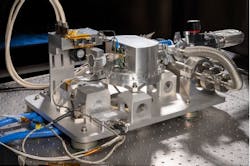NASA-developed sensors aim to use SmallSats for fire detection
WASHINGTON - Two NASA-developed technologies are key components of a new high-resolution sensor for observing wildfires: High Operating Temperature Barrier Infrared Detector (HOT-BIRD), developed with support from NASA’s Earth Science Technology Office (ESTO), and a cutting-edge Digital Readout Integrated Circuit (DROIC), developed with funding from NASA’s Small Business Innovation Research (SBIR) program, NASA reports. Continue reading original article.
The Military & Aerospace Electronics take:
13 June 2025 - The National Aeronautics and Space Administration's (NASA) Jet Propulsion Laboratory, in partnership with Copious Imaging LLC., has developed the Compact Fire Infrared Radiance Spectral Tracker (c-FIRST), a small mid-wave infrared sensor designed to detect wildfires with unprecedented speed and precision. Supported by NASA’s Earth Science Technology Office, c-FIRST uses a compact, high-performance infrared detector (HOT-BIRD) and a digital readout circuit to capture thermal data across five spectral bands and a wide temperature range.
Unlike traditional satellite sensors with long revisit times, c-FIRST is designed for deployment on CubeSats, enabling rapid observations multiple times per day. Artificial inteligence (AI)-driven onboard data analysis will prioritize active fire detection for immediate downlink, enhancing response times. The sensor’s compact design eliminates bulky cryocoolers, making it ideal for small satellite constellations.
Related: NASA and NOAA seek industry partners for space weather sensor development
Jamie Whitney, Senior Editor
Military + Aerospace Electronics
